Copyright 2008 All Rights Reserved
Toy Soldier
Art
Berlin Grays and Spies
While a few toy companies sculpted and cast figures of
opposing troops, many looked to easier methods. One of the better examples of
cheap enemies was by Herald. They
cast their “Khaki Infantry” in grey and painted them with black field gear and
helmets. All it took was a simple
change of color to make acceptable opponents. Paint was all it took to convert British
troops to Communists.
I
have been having fun extending this idea. My examples are created
from figures I cast. The mold contains
copies of three Lone Star British Paratroopers, circa 1950. The uniform and field gear is identical
to that used by World War II British soldiers. The weapons are of later vintage.
My
first attempt was to paint regulation British Paratroopers in Dennison
smocks. Next came standard army
men, some in light green fatigues, some dark green ,and some khaki tan, Then came camouflaged uniforms, such as
the type used by World War II Marines in the Pacific, and a darker green
camouflage of later origin. There
were Italian paratoopers in desert trousers and their unusual camouflage, and
finally German fallschirmjager. The
only extra step I took with the Germans was to file the helmets to look
more like the flat-topped fallschirmjager helmet.
The next sets were a bit more fictitious. There was the “IM Enemies,” based on
enemy troops in the old “Mission Impossible” TV show. There was an all-grey set done to
resemble Italian paratroops in World War II, and a brown set to look like
Communist troops in the 1950s. A
set in Mustard Yellow with khaki tan field gear evoked ideas of desert
troops. Finally, two sets of “spy movie” cadre in blue uniforms.
If you have an eye for detail, you are likely thinking that these
“paint-job conversions” are toys rather than military miniatures. You may be saying, “Paint alone does not
make a credible conversion. Whatever the paint, they are still toy British
paratroopers.” And you would
be right in thinking so. I
am not making accurate military miniatures. I am not even doing credible
conversions. The goal is a
play on similarity, not accurate replication.
There is a lesson here, as well.
Many times, the cut of a uniform is less variable than the color. The military attire of a given time
tends to be similar for all armies, with minor variations. Color and details are the most
variable. The general cut tends to
be the same. You can see this
in the American Revolutionary War, Civil War and World War I. Headgear and some field gear vary is
shape, but the uniform cut is alarmingly similar for all sides in a given
war.
As an aside, there is a connection between military and civilian clothing
styles. They influence each
other. For instance, the shako of
the 19th Century was a military equivalent of the top hat. The fatigue uniform of the mid to late
20th Century was similar to work clothing. Often, the main difference between
civilian and military was a matter of color and small details.
|
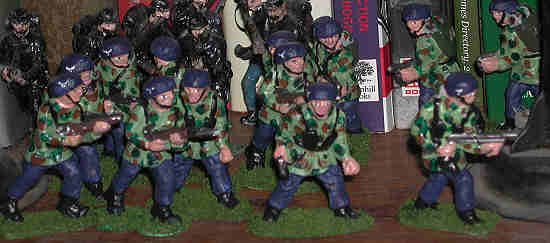 ' '
Painted to resemble German fallschirmjager in green camo
smock. |
|

Berlin grays - these are painted to resemble the enemy types from the
Mission Impossible TV series. Note shoulder boards and collar
tabs. |
|
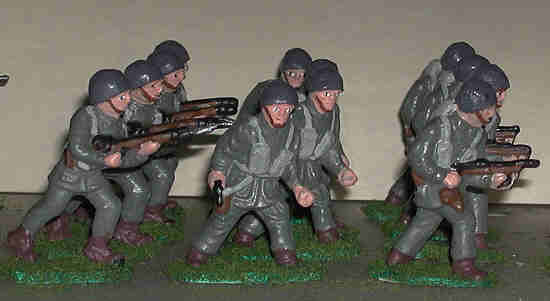
Initially meant to resemble World War II Italian paratroopers.
The gray we used for clothing was not gray enough. It had a greenish
tint. |
|
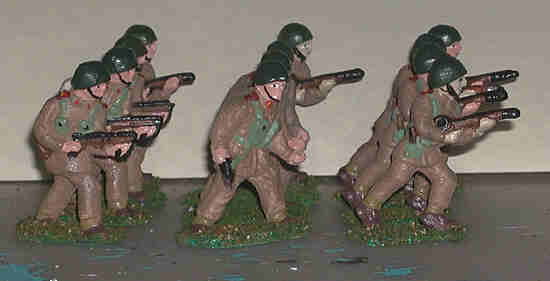
These Berlin Grays are brown. Painted to resemble Communist
troops. |
|
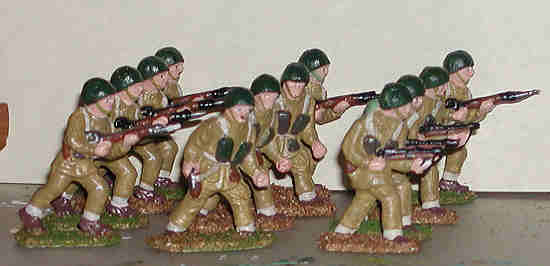
Mustard tan and khaki, reminiscent of desert type uniforms. |
|
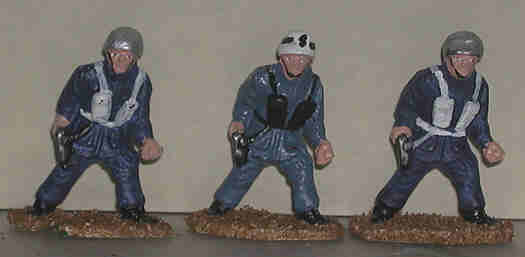
Spy cadre. The outside two have white belts and silver
helmets. The inside man hads black belts and a white helmet with
markings similar to Air Police.. |
.
Contact Us at thortrains@comcast.net
 '
'



